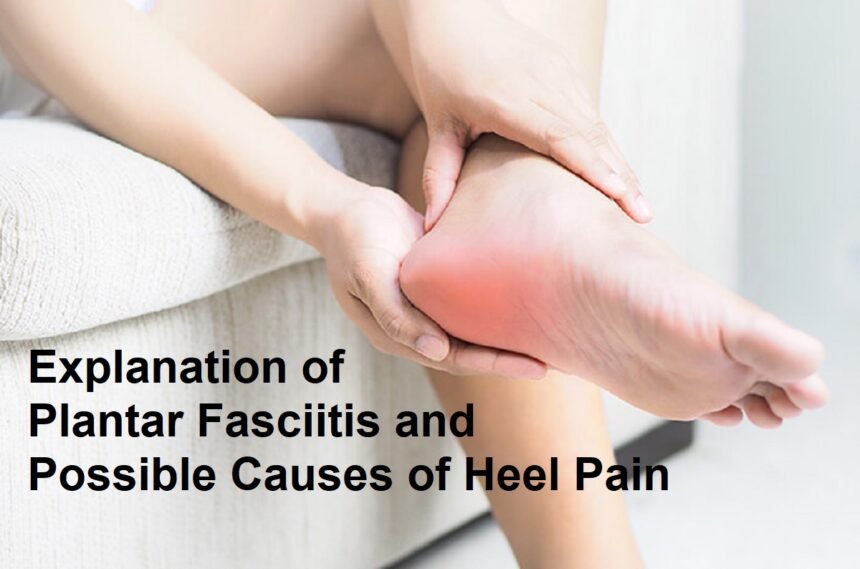Introduction
Heel pain is a common complaint that can significantly affect daily activities, especially for those who spend long hours on their feet. One of the most prevalent causes of heel pain is plantar fasciitis, a condition that develops when the plantar fascia, the thick band of tissue supporting the arch of your foot, becomes inflamed or irritated. Understanding the causes, symptoms, and treatment options for plantar fasciitis is essential for anyone experiencing heel pain.
What Is Plantar Fasciitis?
Plantar fasciitis is an injury or inflammation of the plantar fascia, a ligament-like structure that runs along the bottom of your foot, connecting your heel bone to your toes. The plantar fascia provides support to the arch of your foot and absorbs shock during activities like walking, running, or jumping.
When the plantar fascia experiences excessive stress or repetitive strain, tiny tears can form within the tissue. This triggers inflammation, leading to symptoms like sharp heel pain, especially with the first steps in the morning or after prolonged periods of rest. The pain typically decreases as you move around but may return after prolonged standing or activity.
Symptoms of Plantar Fasciitis
The most prominent symptom of plantar fasciitis is heel pain, characterized by:
- Sharp, stabbing pain in the bottom of the heel.
- Increased pain during the first steps after waking or long periods of rest.
- Pain worsens with activity and improves with rest or ice.
- Tenderness along the bottom of the foot.
- A feeling of stiffness or tightness in the arch.
If untreated or left to worsen, the condition can cause persistent discomfort and even lead to changes in gait or foot biomechanics.
Common Causes and Risk Factors
Plantar fasciitis is multifactorial, meaning several factors can contribute to its development. Some of the most common causes include:
1. Overuse or Excessive Strain
Activities that involve repetitive impact, such as running, jumping, or long-distance walking, place stress on the plantar fascia. Athletes or individuals with physically demanding jobs are particularly vulnerable.
2. Improper Footwear
Wearing shoes that lack arch support or cushioning can increase strain on the plantar fascia. Flip-flops, worn-out shoes, or high heels often fail to provide adequate support, exacerbating the problem.
3. Foot Biomechanics
Structural foot issues, such as flat feet (overpronation), high arches, or abnormal gait patterns, can unevenly distribute weight and increase tension on the plantar fascia.
4. Obesity
Excess body weight adds stress to the plantar fascia and heel, especially during standing or walking. This overload can cause microtears and inflammation over time.
5. Age and Activity Level
Plantar fasciitis is more common in middle-aged adults but can affect people of all ages, especially those who suddenly increase activity levels or start new sports routines.
6. Tight Achilles Tendon
A tight Achilles tendon, the tendon connecting the calf muscles to the heel, can limit ankle movement and increase strain on the plantar fascia.
How to Manage and Prevent Plantar Fasciitis
While plantar fasciitis can be painful, it is treatable with the right approach. Strategies include:
- Rest and Ice: Reduce activity levels and apply ice packs to decrease inflammation and pain.
- Proper Footwear: Wear shoes with good arch support, cushioning, and a slight heel lift to reduce strain.
- Stretching Exercises: Stretching the calf muscles and Achilles tendon can relieve tension on the plantar fascia.
- Orthotics: Use custom or over-the-counter inserts that support the arch and distribute pressure evenly.
- Weight Management: Maintain a healthy weight to decrease load on your heels and feet.
- Physical Therapy: Consult a specialist for targeted exercises and techniques to improve foot mechanics.
In more persistent cases, other treatments like steroid injections, night splints, or, in rare instances, surgery may be recommended.
When to See a Doctor
If heel pain persists beyond a few weeks, worsens, or significantly affects your mobility, it’s important to consult a healthcare professional. Proper diagnosis and treatment plans can prevent further damage and promote quicker recovery.
Conclusion
Heel pain caused by plantar fasciitis can be debilitating but is manageable with proper care and lifestyle adjustments. By understanding the underlying causes—such as overuse, improper footwear, biomechanical issues, obesity, and tight tendons—you can take proactive steps to prevent or alleviate symptoms. Recognizing the signs early and seeking appropriate treatment can help you return to your normal activities pain-free and with healthier foot mechanics.












